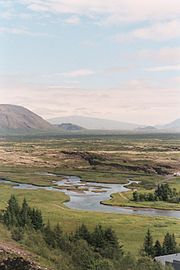Þingvellir/History

(See also:Þingvellir)
Middle Ages
[edit]Viking Age
[edit]In the first half of the 10th century, Iceland had probably around 50.000 inhabitants. The settlement mostly by Norwegian vikings and their entourage had began around AD 874.
-
Viking voyages, among others to Iceland
The new country needed an organisation and people decided to found here a parliament, a whole-country-thing (= Alþingi) after the example of their Norse forefathers and kin. The parliament Alþingi was founded in 930 on the plains of Þingvellir which had newly come into possession of the state, where in the summer time, when the parliament meetings were to take place for 2 weeks in June each, was a lot of water and fodder for horses and which were easily to reach from all parts of the country.
-
The plains of Þingvellir
Up to 50 chieftains with an entourage of 3 persons each sat in the Alþingi. The parliament, one of the oldest of Europe, had jurisdictional and legislative functions. The law speaker (lögsögumaður) was the most important person, because he could recite the laws and decide in case of divergence of opinions
-
The parliament Alþingi was founded in 930 on the plains of Þingvellir
-
Lögberg: The meeting place
-
But the more probable place for the Lögberg is here within the chasm of Almannagjá, because it is protected from the weather
-
The law speaker (lögsögumaður)
-
During the time of the Thing, people stayed over night in sort of a tent which was placed over stone walls
The parliament met here til in 1798, but lost its power after 1262, when the country became a province of Norway and later of Denmark.
Religion
[edit]Conversion to Christianity
[edit]From the beginning of settlement, there had been Christians among the settlers. In the year AD 1000, the conflict between pagans adhering to the Norse religion and the Christians culminated in a dispute during the summer meeting of Alþingi. It ended with the conversion to Christianity, but with some compromises, initiated by Þorgeir Ljósvetningagoði, the Law speaker of the time. From this time, till in 1551, when the Icelanders converted to Lutheranism, they were Catholics.
-
Goðafoss: The same law speaker is said to have disposed of his statues of the old gods into this waterfall, when he returned from Þingvellir
-
An Icelandic bible from the 14th century
Churches at Þingvellir
[edit]The first church at Þingvellir was built on the initiative of St. Olaf, King of Norway, who sent church timbers and a bell to Iceland shortly after the adoption of Christianity around AD 1000. The present Þingvellir Church was consecrated in 1859. The tower was rebuilt in 1907. Behind Þingvellir Church is the National Cemetery, which dates from 1939. Poets Jónas Hallgrímsson (1807-45) and Einar Benediktsson (1864-1940) are buried there.
-
Church and Manorhouse at Þingvellir
-
Church and Manorhouse
-
Interior of today's Lutheran church of Þingvellir
Stóridómur: Court of Justice in the age of pietism
[edit]From 1564 til the middle of the 18th century, there existed in Þingvellir a Court of Justice, called Stóridómur, which a.o. imposed death penalty in case of capital crimes, but also in case of misconducts like adultery. The capital punishments were also carried out at Þingvellir: Men were beheaded, women were drowned in the drowning pool Drekkingarhylur in Öxará.
-
The Drowning Pool
-
The Drowning Pool draining into Öxará
Þingvellir as a symbol of national identity in the 19th, 20th and 21st centuries
[edit]19th century
[edit]The poete Jónas Hallgrímsson worked in Copenhague for the independance of Iceland and for a revival of the parliament at Þingvellir, but in the end it was reestablished in Reykjavík on the proposal of Jón Sigurðsson. In the year 1874, thousand years after the first acknowledged settlement, there was held in Þingvellir a festival on the occasion. Christian IX. of Denmark visited Iceland at this time and presented the country its first constitution: Danmark granted the country home rule.
-
Jónas Hallgrímsson
-
Þingvellir in the 19th century
-
Christian IX of Denmark
20th century
[edit]Beginning of the 20th century
[edit]A constitutional amendment, confirmed on 3 October 1903, granted the Icelanders home rule and parliamentary government. Hannes Hafstein was appointed as the Icelandic minister on 1 February 1904 who was answerable to parliament. The Act of Union which took effect on 1 December 1918 made Iceland a state in personal union with the king of Denmark. It was set to expire after 25 years, when either state could choose to leave the union.
-
w:Fridrik VIII. of Denmark and Hannes Hafstein in Þingvellir (1908)
-
A post stamp in relation to the celebrating of the thousand-year anniversary of Alþingi in 1930
Foundation of the National Park in 1928 and Thousand-year-anniverary of Alþingi
[edit]In 1928, the National Park of Þingvellir was founded following the example of national parks in the USA. Many Icelanders and guests from other countries attended the ceremonies. Two years later, there was held at the place another great festivity on the occasion of the thousand-year-anniversary of the Icelandic parliament.
-
Women in national costumes
-
Christian X. of Denmark in Þingvellir, 1930
-
Church and manor house in 1930
-
Students from the Faroe Islands at the festivities, 1930
Around the turning of the millenium
[edit]At the beginning of the 21st century, Iceland is an independent country since 1944, the parliament is still in Reykjavík, but Þingvellir plays a role eg. in National Day ceremonies. The national park is a major attraction for visitors from Iceland and abroad. And sometimes, the Ásatrúar, which took up the old tradition of Norse religion, hold their ceremonies in the national park.
-
Entrance to Almannagjá in 2004
-
Ásatrúar at Þingvellir



























